Rust Family Foundation: Archaeology Grants Program
Dating the Transition from Foraging To Farming in the Belize River Valley:
Results from the 2018 BVAR Project Field Season
[RFF-2018-71]Principal Investigators:
Dr. Claire EbertNorthern Arizona University; BVAR Project Assistant Director
Dr. Jaime Awe
Northern Arizona University; BVAR Project Director
.
This project addresses one of the most significant concerns in social science research, the transition from foraging to farming and origins agricultural subsistence economies. Residentially mobile hunter-gatherer lifestyles dominated human social and economic systems until the last 10,000 years, when plants and animals domestication occurred in multiple regions of the world. Food production subsequently played a key role in the emergence of political structures for the control of food surplus, highly integrated agricultural systems supporting large populations, and social hierarchies worldwide. Funding from the Rust Family Foundation was provided to members of the the Belize Valley Archaeological Reconnaissance (BVAR) Project to conduct archaeological excavations and laboratory analyses to investigate the transition from foraging to farming in the Belize Valley, located in the central Maya lowlands.
In the Maya region, the Archaic period (~7000-2000/1000 cal BC) represents the critical interval when subsistence strategies shifted from wild resources to focus on domesticates (Kennett 2012; Rosenswig 2015). Direct dates on human burials and hearths from rockshelters in the Bladen region of southern Belize provide some of the earliest evidence for habitation in the Maya lowlands by hunter-gatherers around 7000 cal BC (Prufer et al. 2017). Archaeological and genetic evidence indicates that domesticates including maize (Zea mays) and squash (Curcurbita sp.) were cultivated by Archaic hunter-gatherers as part of their mixed foraging/farming economies beginning around 3500 cal BC (Piperno and Smith 2012; Pohl et al. 1996). Evidence for sedentary farming communities in the Maya lowlands occurred between 1200-1000 BC at the end of the Early Preclassic period (Ebert et al. 2017; Inomata et al. 2013). The Preclassic period represents one of the most critical periods in ancient Maya prehistory, when the development of sedentary village life, increased reliance on maize agriculture, and the adoption of ceramic technology first appear. The timing and relationship of these developments to changing environmental and economic circumstances remains poorly understood.
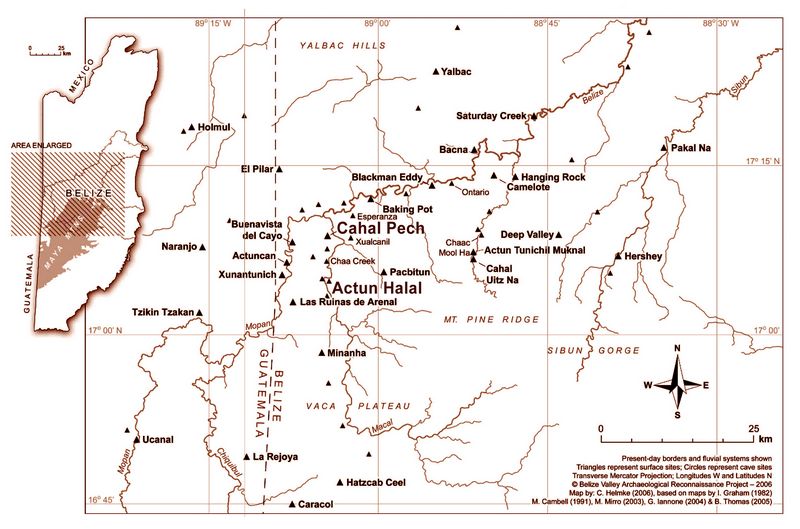
Fig.1: Map of western Belize showing locations of Cahal Pech, Actun Halal and major regional centers.
Characterizing the transition from foraging to farming in the Maya lowlands has traditionally relied on relative dating using stylistic typologies of Archaic lithic points and Preclassic ceramics. The result is chronologies that span hundreds of years, preventing precise temporal assignments for discrete events that are essential for recording patterns of subsistence and settlement change. A small number of radiocarbon dates suggest overlap between mobile hunter-gatherer populations and the first sedentary Maya communities (see Clark and Cheetham 2002; Lohse 2010; Stemp et al. 2016), however, no continuous directly dated primary sequence links the two contexts. Additionally, while tentative evidence suggests that Late Archaic peoples had access to maize and other domesticates, it is unclear how they were incorporated into their diets and how this altered settlement patterns. The focus of this project is to gain insight into this crucial, yet poorly understood transformation in human subsistence and settlement patterns, because a shift from a reliance on primarily wild to domesticated resources set the stage for the development of complex societies across the Maya lowlands.
Previous Work in the Region:
Few sites in the Maya lowlands have produced contextual evidence of Late Archaic hunter-gatherer occupation, and Preclassic period contexts are often deeply buried beneath later Classic period (~AD 250-900/1000) monumental architecture, making them relatively inaccessible (Rosenswig 2015). In the Belize Valley (fig.1
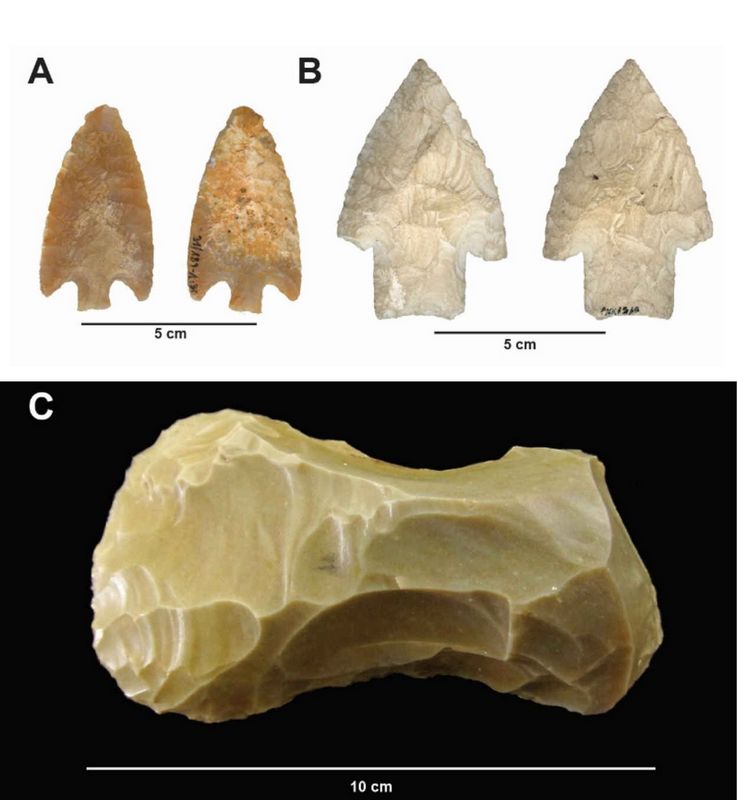 ), the region of focus for this project, archaeological evidence for
pre-ceramic (i.e., Archaic) occupation is characterized by the presence
of stemmed or barbed chert points (i.e., Lowe and Sawmill points, fig.2) and constricted adzes dating to the Late Archaic (Stemp et
al. 2016). While most points and other formal lithic tools are surface
finds, radiocarbon dates associated with some of these artifacts
tentatively place them between ~2500-1900 cal BC.
), the region of focus for this project, archaeological evidence for
pre-ceramic (i.e., Archaic) occupation is characterized by the presence
of stemmed or barbed chert points (i.e., Lowe and Sawmill points, fig.2) and constricted adzes dating to the Late Archaic (Stemp et
al. 2016). While most points and other formal lithic tools are surface
finds, radiocarbon dates associated with some of these artifacts
tentatively place them between ~2500-1900 cal BC.Fig.2: Examples of diagnostic Archaic period lithic artifacts including a (A) Sawmill point and (B) Lowe point, and (C) unifacial constricted adze.
The most secure evidence for Archaic period hunter-gatherer occupation in the Belize Valley region comes from the site of Actun Halal Rockshelter (Figure 3; Griffith and Helmke 2000). Radiocarbon dates analyzed in 2007 from pre-ceramic deposits containing small amounts of lithic debitage, a constricted adze, and fire-cracked limestone cobbles document periodic use of the site by Archaic peoples between ~2400-1200 cal BC (Lohse 2010). While the analysis of pollen samples from associated contexts included maize and cotton (Jones and Hallock 2007), there is currently no evidence that cultivation of domesticates was pursued on a scale large enough to alter hunter-gather subsistence and settlement strategies.
Other macrobotanical and faunal remains suggest, rather, a mixed economy that may have incorporated low-level food production along with the collection of wild plants and hunting of forest animals (e.g., white-tailed deer, armadillo, agouti; Lohse 2010). After a period disuse at the end of the Archaic, ceramic data indicate resumed activity at Actun Halal during the Middle Preclassic (LeCount 2007), with later use of the site by the Classic Maya for primarily ceremonial purposes (Griffith and Helmke 2000).
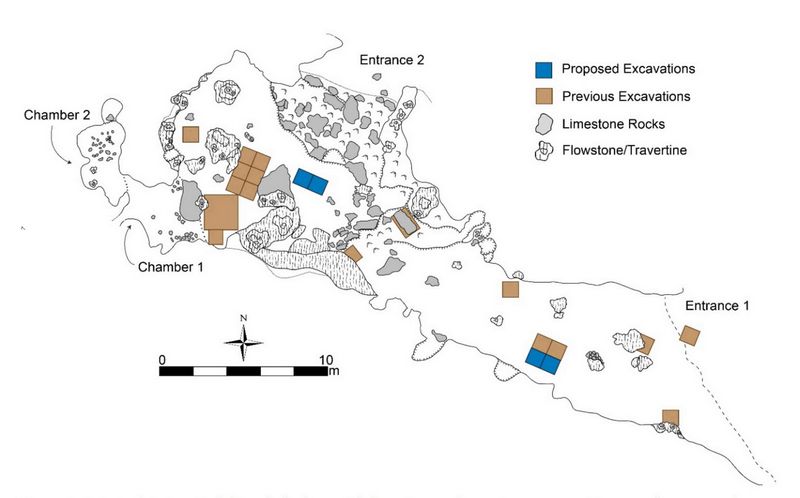 .
.Fig.3: Map of Actun Halal Rockshelter with locations of previous excavations and proposed excavations for 2019 targeting Archaic period contexts (after Griffith and Helmke 2000).
Excavations and associated radiocarbon data document the founding of Early Preclassic villages in the Belize Valley at the sites of Cahal Pech (Awe 1992; Sullivan et al. 2018), Blackman Eddy (Garber et al. 2004), and Xunantunich (Brown et al. 2011), marked by the appearance of the Cunil complex ceramics between 1200-1000 cal BC. Stratigraphic excavations conducted by the Belize Valley Archaeological Reconnaissance (BVAR) Project at Cahal Pech (fig.4) in both the site epicenter and settlement have produced the best-dated chronology for initial settlement in the Belize Valley (see Awe 1992; Ebert et al. 2017). Contexts representing the earliest settlement in the civic-ceremonial site core are directly dated to the Cunil ceramic phase (1200-900 cal BC). Cunil phase strata, which include evidence of domestic architecture, are located directly on top of black paleosols that contain only a very small number of ceramic sherds with higher concentrations chert flakes and tools and freshwater shells (Ebert et al. 2017). Research conducted at Cahal Pech in Plaza B during the summer 2017 and 2018 field seasons by Ebert and Awe, in collaboration with the BVAR Project, have identified stratified components below paleosols that may potentially date to the Archaic (Ebert 2018; Ebert et al. 2019).
Impressions of corn cobs on pottery from household contexts, and maize cupule fragments indicate that maize production formed an important component of the diet during the Early and Middle Preclassic (Lawlor et al. 1995). The Preclassic Cahal Pech community also exploited a variety of other plants from the surrounding forest and house gardens, including squash (Curcurbita sp.) and fruits (Wiesen and Lentz 1997). Excavations of an Middle to Late Preclassic midden have yielded a large sample (n>25,000) of terrestrial, freshwater, and marine faunal remains representing a diet in which maize was not the only source of protein (Powis et al. 1999; Stanchly and Awe 2015:230). Stable carbon and nitrogen isotope analyses from radiocarbon dated human skeletal remains from Cahal Pech also indicate that this broad subsistence, incorporating both wild and domesticated foods, persisted throughout the Preclassic (Ebert 2017).
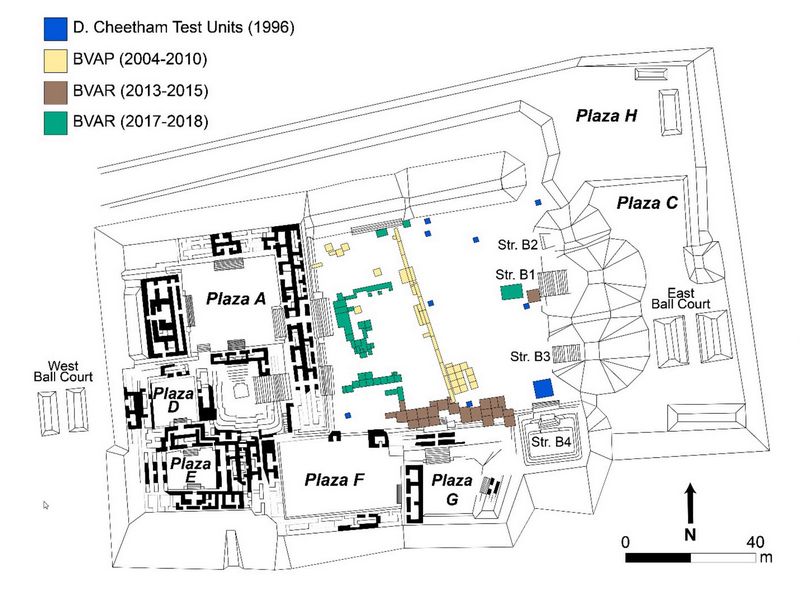 .
. Fig. 4: Cahal Pech site core showing locations of major Plaza B excavations from 1996 through 2018 (map by C. Ebert, 2018).
Current Funded Project (RFF-2018-71):
Goals:
The goal of this project is to document Archaic and Early Preclassic contexts to determine the activities that defined the subsistence economies for both periods (e.g., food procurement and/or production, tool manufacture). Previous explanations for the transition from foraging to farming have, therefore, described this processes as an abrupt change in the production and distribution of subsistence resources. Funding from the Rust Family Foundation was used for AMS 14C analyses to identify these contexts that will help address the following questions.
1. What was the timing and pace of the Archaic to Preclassic period transition in the Belize Valley?
2. How did changing climate conditions impact changes in subsistence and settlement choice from the Archaic through Early/Middle Preclassic periods in the Belize Valley?
Methods:
A total of 15 samples of organic remains were analyzed for AMS 14C from two sites: Actun Halal Rockshleter and Cahal Pech (table 1). Sample processing analyses was conducted at the Penn State Human Ecology and Isotope Geochemistry Lab (Penn State University, Department of Anthropology) and the Penn State AMS Facility according to standard procedures. All samples considered for this study were charcoal or other plant materials, as no bone suitable for dating was encountered during excavations or present in curated collections. For all selected samples, carbonized short-lived samples (e.g., twigs, seeds, corn kernels) were selected for dating to reduce erroneous age assignments from the “old wood effect” (Schiffer 1986). All dates are reported in table 1 as conventional 14C ages corrected for fractionation, with measured d13C following Stuiver and Polach (1977). Date calibrations and stratigraphic models were produced in OxCal v.4.3 (Bronk Ramsey 2009) using the IntCal13 Northern Hemisphere atmospheric curve (Reimer et al. 2013). Calibrated and modeled date ranges are reported at the 2-s level.
Results:
Two samples of macrobotanical remains from Actun Halal successfully produced dates. Samples were selected from paleobotanical remains collected at the site during excavations by Griffith in 2000 (Griffith and Helmke 2000). These remains were analyzed to genus and species, when possible, and selected samples included domesticates such as Zea mays (corn kernels), as well as Pinus sp. (pine) which does not naturally grow in the area, suggesting it was brought to the site by the ancient Maya. All samples from Actun Halal were strategically selected from deposits reported to be stratified (Griffith and Helmke 2000). Dates for these samples span from the Middle Preclassic (790-425 cal BC, Zea mays) to the Early Classic period (AD 250-390, Pinus sp.) suggesting continuous use of the rockshelter during thing period. The large span of these two samples may also indicate that deposits in Actun Halal are mixed. Additional strategically placed and controlled excavations are planned for the 2019 summer field season to locate earlier Archaic contexts.
The remainder of our dates come from contexts at Plaza B located in the Cahal Pech monumental epicenter (n=13). Samples from Plaza B were recovered in situ from stratified contexts encountered during excavations in the mid-1990s by Cheetham and between 2017 and 2018 by Ebert (see Ebert 2018; Ebert et al. 2019 for more information). Sampled contexts include isolated features (e.g., caches), construction fill, and in association with plaster floors and other architectural features believed to be Early Preclassic in date.
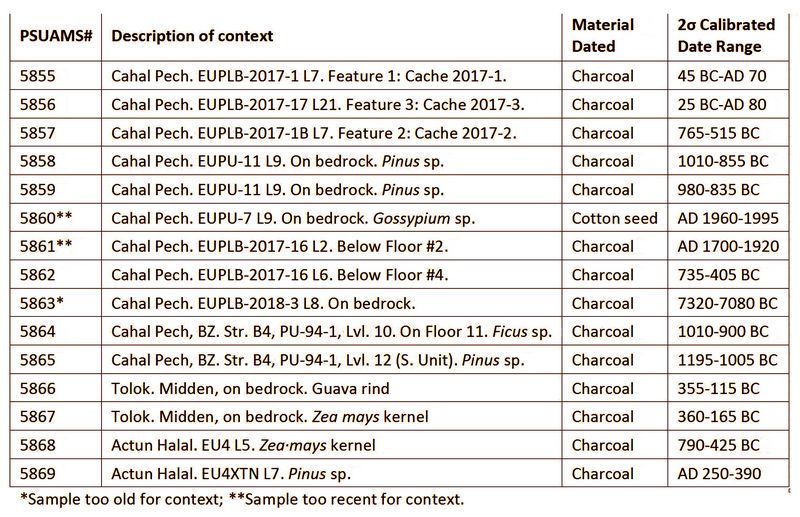
Table 1: Results of AMS 14C dating from Actun Halal and Cahal Pech.
Results of 14C dates span from the end of the Early Preclassic through modern times suggesting a more complicated picture of settlement at the site. The earliest sample collected from 2018 excavations directly in bedrock dates to 7320-7080 cal BC (PSUAMS-5863). We believe that this date is too early for the context we are dating, and instead is likely old wood from the original paleosol present prior to occupation at Cahal Pech. Two other anomalous dates were also analyzed, which date to the historic (PSUAMS-5861; cal AD 1700-1920) and modern periods (PSUAMS-5860; cal AD 1960-1995). Archeological evidence for more recent activities at the site includes the presence of United States coins and porcelain pipe fragments dating to the early 20th century. Cahal Pech was also a known campsite of the British West India Regiment much later during the early 1900’s (Awe 1992: 172). Today Cahal Pech is one of the most visited archaeological sites in Belize, and Plaza B experiences heavy foot traffic on a daily basis. Taphonomic processes moving plant materials through sediments associated with the modern ground surface likely accounts for some of these unexpectedly late dates.
A total of four samples, however, dated from Cahal Pech date to the Early Preclassic. Two samples were collected from directly on top of bedrock during excavations in Plaza B (PSUAMS-5858 and PSUAMS-5859) and date between 1010-835 cal BC. An additional two Early Preclassic samples were collected from Structure B4, a 5.5m high temple located at the southeastern corner of Plaza B. Early Preclassic contexts in Plaza B and Structure B4 include initial construction of agrarian residences at the site, which consisted of the remodeling of a series of superimposed living surfaces composed of tamped earth floors supporting wattle-and-daub superstructures (Awe 1992; Peniche May 2016). Middle and Late Preclassic dates were produced from samples associated with three caches (PSUAMS-5855, -5856, and -5857; Ebert 2018) located in Plaza, as well as a large platform that may be associated with a Middle Preclassic E-Group Assemblage (Ebert et al. 2019).
Three additional samples from Cahal Pech from the Tolok settlement group were also chosen for dating. These samples were recovered from the Preclassic midden. For the Tolok samples, paleobotanical analyses by Wisen and Lentz (1997) identified early examples of domesticates (squash, corn, guava) which would help to determine the types of domesticated foods important to the early Cahal Pech community. Only two samples from the Tolok settlement group were successfully dated after laboratory processing (PSUAMS-5866 and PSUAMS-5867). The dates of these samples suggest that people were consuming domesticated plants like corn and guava (locally known as guayaba) in the Late Preclassic (360-115 cal BC).
Ongoing Research and Future Directions
Continued excavation at Cahal Pech and Actun Halal are scheduled for the summer 2019 BVAR Project field season. Test units will be placed in areas that contain previous evidence for stratified occupational phases to recover temporally diagnostic materials, and also to expose possible activity areas associated with different food production activities. Based on the presence of possible mixed deposits at Actun Halal suggested by initial AMS 14C results, our goal is to pinpoint discrete features for excavation. We will be working to implement a geophysics survey to identify features such as hearths that may potentially be associated with Archaic period materials.
Research this coming summer will also implement a systematic program of plaeobotanical analyses at both Actun Halal and Cahal Pech. Sampling for paleobotanical remains will allow for greater stratigraphic and spatial control from securely excavated contexts. This study will apply a blanket sampling strategy for flotation in which samples are collected from all excavated contexts for AMS 14C dating (Pearsall 2015). The initial results of our AMS 14C analyses and ongoing fieldwork will be presented to academic and local Belizean audiences during at the 2019 Belize Archaeology Symposium held in June in San Ignacio, Belize.
Future research will also focus on additional chronology building efforts for the Archaic to Preclassic transitions. A more precise chronology can be compared to other datasets (e.g., paleoclimate, artifact, zooarchaeological, paleobotanical) for early contexts in the Belize Valley to identify the underlying processes related to subsistence and settlement change. Comparisons with paleoenvironmental records will provide important information on changes in food production associated with severe droughts. Pollen and other microfossils preserved in sedimentary environments, in addition to paleobotanicals recovered from excavated contexts, will allow for modeling type of plants available during the Archaic and Preclassic based on temporal associations.
References:
Awe, Jaime J.
1992 Dawn in the Land between the Rivers: Formative Occupation at Cahal Pech, Belize, and its Implications for Preclassic Development in the Central Maya Lowlands. Unpublished Ph.D. Dissertation, Institute of Archaeology, University of London, London.
Bronk Ramsey, Christopher
2009 Bayesian Analysis of Radiocarbon Dates. Radiocarbon 51: 337-360.
Brown, M. Kathryn, Jennifer Cochran, Leah McCurdy, and David Mixter
2011 Preceramic to Postclassic: A Brief Synthesis of the Occupation History of Group E, Xunantunich. Research Reports in Belizean Archaeology 8: 209-220.
Clark, John E. and David Cheetham
2002. Mesoamerica’s Tribal Foundations. In The Archaeology of Tribal Societies, edited by William A. Parkinson, pp. 278-339. International Monographs in Prehistory. University of Michigan, Ann Arbor.
Ebert, Claire E.
2017 Preclassic Social Complexity and Origins of Inequality at Cahal Pech, Belize. Unpublished Ph.D. Dissertation. Department of Anthropology, The Pennsylvania State University, University Park, PA.
2018 Preclassic plaza investigations at Cahal Pech, Belize: Results of the 2017 Excavations in Plaza B. In The Belize Valley Archaeological Reconnaissance Project: A report of the 2017 field season, edited by Claire E. Ebert, Julie A. Hoggarth, and Jaime J. Awe, pp. 1-47. Institute of Archaeology, Baylor University, Waco; Department of Anthropology, Northern Arizona University, Flagstaff.
Ebert, Claire E., James McGee, Krystal Dudash, and Mark Porter
2019 Early Monumentality in the Belize River Valley: Excavations of a Preclassic E-Group Assemblage at Cahal Pech, Belize. In The Belize Valley Archaeological Reconnaissance Project: A report of the 2017 field season, edited by C. E. Ebert, J. P. Walden, J. A. Hoggarth, and J. J. Awe, pp. 1-23. Department of Anthropology, Northern Arizona University, Flagstaff.
Ebert, Claire E., Nancy Peniche May, Brendan J. Culleton, Jaime J. Awe, and Douglas J. Kennett
2017 Regional response to drought during the formation and decline of Preclassic Maya societies. Quaternary Science Reviews 173: 211-235.
Garber, James F., M. Kathryn Brown, Jaime J. Awe and C. J. Hartman
2004 Middle Formative prehistory of the central Belize Valley: An examination of architecture, material culture, and sociopolitical change at Blackman Eddy. In The Ancient Maya of the Belize Valley: Half a Century of Archaeological Research, edited by James F. Garber, pp. 25-47. University Press of Florida, Gainesville.
Griffith, Cameron S. and Christophe G. Helmke
2000 Preliminary Investigations and GIS Spatial Analysis in Actun Halal, Belize. In The Western Belize Regional Cave Project: A Report of the 2000 Field Season, edited by Jaime J. Awe, pp. 98-113. Department of Anthropology Occasional Paper No. 3. University of New Hampshire, Durham.
Inomata, Takeshi, Daniela Triadan, Kazuo Aoyama, Victor Castillo, and Hitoshi Yonenobu
2013 Early Ceremonial Constructions at Ceibal, Guatemala, and the Origins of Lowland Maya Civilization. Science 340: 467-471.
Jones, John G. and Ashley Hallock
2007 Appendix C: Analysis of Fossil Pollen from Actun Halal, Belize. In pp. 47-54. In In Search of the Preceramic: 2006 Season Investigations at Actun Halal, Belize, edited by Jon C. Lohse, pp. 47-54. Report submitted to the Institute of Archaeology, National Institute of Culture and History, Belmopan. Center for Archaeological Studies, Texas State University–San Marcos.
Kennett, Douglas J.
2012 Archaic-period foragers and farmers in Mesoamerica. In The Oxford Handbook of Mesoamerican Archaeology, edited by Deborah L Nichols and Christopher A. Pool, pp. 141–150. Oxford University Press, New York.
Lawlor, E. J., A. J. Graham and S. L. Fedick
1995 Preclassic Floral Remains from Cahal Pech, Belize. In Belize Valley Preclassic Maya Project: Report on the 1994 Field Season, edited by Paul F. Healy and Jaime J. Awe, pp. 150-165. Trent University Department of Anthropology Occasional Paper No. 10, Peterborough, Ontario.
LeCount, Lisa J.
2007 The Ceramics of Actun Halal. In In Search of the Preceramic: 2006 Season Investigations at Actun Halal, Belize, edited by Jon C. Lohse, pp. 36–46. Report submitted to the Institute of Archaeology, National Institute of Culture and History, Belmopan. Center for Archaeological Studies, Texas State University–San Marcos.
Lohse, Jon C.
2010 Archaic Origins of the Lowland Maya. Latin American Antiquity 21: 312-352.
Pearsall, Deborah M.
2015 Paleoethnobotany: A Handbook of Procedures. Third Edition. Routledge, New York.
Peniche May, Nancy
2016 Building Power: Political Dynamics in Cahal Pech, Belize during the Middle Preclassic. Unpublished Ph.D. Dissertation, Department of Anthropology, University of California, San Diego, San Diego.
Piperno, Dolores R. and Bruce D. Smith
2012 The origins of food production in Mesoamerica. In The Oxford Handbook of Mesoamerican Archaeology, edited by D. L. Nichols and C. A. Pool, pp. 151–164. Oxford University Press, New York.
Pohl, Mary D., Kevin O. Pope, John G. Jones, John S. Jacob, Dolores R. Piperno, Susan D. deFrance, David L. Lentz, John A. Gifford, Marie E. Danforth and J. Kathryn Josserand
1996 Early Agriculture in the Maya Lowlands. Latin American Antiquity 7: 355–372.
Powis, Terry G., Norbert Stanchly, Christine D. White, Paul F. Healy, Jaime J. Awe and Fred Longstaffe
1999 A reconstruction of Middle Preclassic Maya subsistence economy at Cahal Pech, Belize. Antiquity 73: 364-376.
Reimer, Paula J., Edouard Bard, Alex Bayliss, J. Warren Beck, Paul G. Blackwell, Christopher Bronk Ramsey, Caitlin E. Buck, Hai Cheng, R. Lawrence Edwards, Michael Friedrich, Pieter M. Grootes, Thomas P. Guilderson, Haflidi Haflidason, Irka Hajdas, Christine Hatté, Timothy J. Heaton, Dirk L. Hoffmann, Alan G. Hogg, Konrad A. Hughen, K. Felix Kaiser, Bernd Kromer, Sturt W. Manning, Mu Niu, Ron W. Reimer, David A. Richards, E. Marian Scott, John R. Southon, Richard A. Staff, Christian S. M. Turney and Johannes van der Plicht
2013 IntCal13 and Marine13 radiocarbon age calibration curves 0–50,000 years cal BP. Radiocarbon 55(4):1869–87.
Rosenswig, Robert M.
2015 A Mosaic of Adaption: The Archaeological Record for Mesoamerica’s Archaic Period. Journal of Archaeological Research 23: 115-162.
Schiffer, Michael B.
1986 Radiocarbon dating and the “old wood” problem: The case of the Hohokam chronology. Journal of Archaeological Science 13: 13-30.
Stanchly, Norbert and Jaime J. Awe
2015 Ancient Maya Use of Dog (Canis Lupus Familiaris): Evidence from the Upper Belize River Valley. Research Reports in Belizean Archaeology 12: 227-237.
Stemp, W. James, Jaime J. Awe, Keith M. Prufer and Christophe G. B. Helmke
2016 Design and Function of Lower and Sawmill Points from the Preceramic Period of Belize. Latin American Antiquity 27: 279-299.
Stuiver, Minze and Henry A. Polach
1977 Discussion: reporting of 14C data. Radiocarbon 19: 355-363.
Sullivan, Lauren A., Jaime J. Awe, and M. Kathryn Brown
2018 The Cunil Complex: Early Villages in Belize. In Pathways to complexity: A view from the Maya Lowlands, edited by M. Kathryn Brown and George J. Bey III. pp. 35-48. University Press of Florida, Gainesville.
Wiesen, Anne and David L. Lentz
1997 Preclassic Floral Remains at Cahal Pech and Pacbitun, Belize: Summary Report. In Belize Valley Preclassic Maya Project: Report on the 1996 and 1997 Field Seasons, edited by Paul F. Healy, pp. 53-68. Department of Anthropology Occasional Paper No. 13. Trent University, Peterborough, Ontario.
Recent Foundation grants: general Archaeology Grants Program w/map
Copyright © 2019 Rust Family Foundation